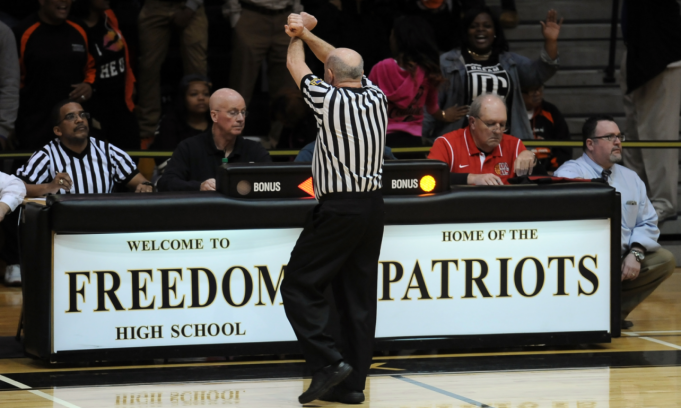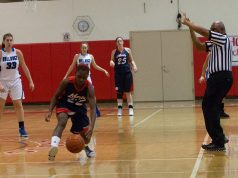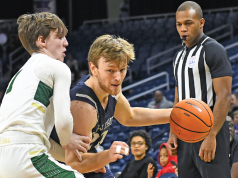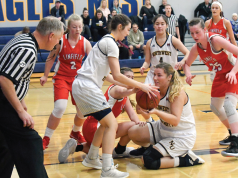You just called a technical, intentional or flagrant foul. These are atypical plays in your game, and you may be unsure just how to administer the ensuing action.
Depending on the level of play, how to administer these atypical plays can differ. However, for whatever game you’re working, there are a few steps that are common to all.
The first step should be to slow down. Once the whistle blows, the clock stops and all eyes turn to you. This is not the time to be in a hurry.
Second, get together with your partners. They can help determine your next steps before you go to the table and report what you have. They may have additional information to help you make the correct decision — for example, maybe that intentional foul should be upgraded. This will also allow your brain time to settle and process what just happened as the adrenaline stops coursing through your veins.
Finally, once you have made your decision and determined how to resume play, you can take your call to the table and report. In this article, we will cover the differences between these three types of fouls in the NFHS rulebook.
Technical fouls
Rule 4-19-5 defines what a technical foul is, while rules 10-1 through 10-6 define the different types of technical fouls. What we’re most concerned with in this article are the penalties for the different technical fouls.
For all technical fouls in a high school game (except double technical fouls), the offended team will receive two free throws plus the ball for a division-line throw-in opposite the scorer’s table. The free throws can be shot by any member of the offended team. From there, depending on the type of technical, there are additional considerations.
Administrative technical (10-1)
The technical counts toward the team foul count but is not charged to any individual, and the head coach does not lose the use of the coaching box. Only one technical foul is charged regardless of the number of offenders for each article of the rule, and they need to be penalized when they occur. If a coach realizes a substitute is not in the scorebook, he or she can decide not to use that player, and there is no infraction as the scorebook was not changed. Also, if the penalty is not assessed when the change is made or the error discovered, it cannot be enforced later.
Team technical (10-2)
Each type of team technical is penalized when it occurs or is discovered. Again, the technical counts toward the team foul count but is not charged to any individual, and the head coach does not lose the use of the coaching box.
Substitute technical (10-3)
If a substitute violates by entering the court without reporting to the scorer and before being beckoned by an official, except between quarters and during a timeout, only one foul is charged. The violation must be penalized before the ball becomes live. This technical foul counts not only toward the team foul count but also toward the substitute’s individual foul and technical foul count.
Player technical (10-4)
While there are 10 articles detailing everything a player can do to receive a technical foul, the penalty for each is the same. A player technical counts not only toward the team foul count but also toward the player’s individual foul and technical foul count.
Bench technical (10-5)
Articles 1-4 apply to bench personnel, including the head coach, and outline bench conduct and decorum. If the technical is for being charged with fighting (10-5-1g), the offender is disqualified for a flagrant foul. If the offender is the head coach, the foul is charged directly to him or her; otherwise, the offender is charged, and the head coach receives an indirect technical.
A single flagrant foul or second technical charged to any bench personnel, except the head coach, results in disqualification — the head coach requires two direct or any combination of three direct or indirect technical fouls to be disqualified. Ejected adult bench personnel must leave the vicinity (out of sight and sound) of the playing area immediately and cannot have any further contact with the team for the remainder of the game.
The penalty also outlines that if certain acts, such as objecting to a decision or team members continuously standing during liveball play, are judged to be minor, the official may warn the head coach using the procedure outlined in rule 4-48.
Article 5 deals with leaving the confines of the bench during a fight or when a fight may occur. Remember, head coaches and any number of assistant coaches may enter the court to prevent the situation from escalating.
The penalty for leaving the bench during a fight or when one may occur is a flagrant foul and disqualification of the offender, but only one technical-foul penalty is administered regardless of the number of offenders. This foul is also charged indirectly to the head coach unless that coach was also an offender, in which case an additional flagrant technical foul is charged directly to the coach and penalized. If simultaneous technical fouls by opponents occur, no free throws are awarded when the penalties offset.
Head coach’s rule (10-6)
This rule outlines conduct by the head coach and includes provisions related to the coaching box. Rule 10-6.1a states if a head coach receives a direct or indirect technical foul, the penalty includes the loss of coaching box privileges, resulting in the head coach remaining seated for the remainder of the game (with certain exceptions). If the technical is for violations of articles 3-5, such as allowing a disqualified player to participate in the game, they must be penalized when discovered.
The penalty also outlines that for minor offenses outlined in rule 10-6.1, the official may warn the head coach using the procedure described in rule 4-48.
Intentional fouls
Remember, intentional fouls include contact that takes place during live-ball action that may or may not be premeditated and is not based solely on the severity of the act.
Keep that second point in mind when considering contact that neutralizes an opponent’s obvious advantageous position. If the defender commits a foul on a breakaway, it does not need to be a “hard” foul for it to be ruled an intentional foul.
This is where taking that extra second to process the entire play, and getting together with a partner before reporting to the table, is critical to making the correct decision whether to upgrade a foul.
If you have contact that rises to the level of an intentional foul during a dead ball — except for a foul by an airborne shooter — by rule, it is a technical foul.
The penalty for an intentional foul is two free throws (three on an unsuccessful three-point field-goal try) to the offended player plus the ball to the offended team for a throwin at the designated spot closest to where the foul occurred. The foul counts toward an individual’s five personal fouls for disqualification (Rule 10 Penalties Summary).
Flagrant fouls
Flagrant fouls can be a personal or technical foul. They can occur during a live or dead ball and typically involve either violent contact — think a two-handed shove into the wall on a player attempting a fast-break layup — or persistent, vulgar or abusive conduct.
Fighting is always a flagrant act and does not require contact to be made. It also includes unsporting acts (such as taunting) that cause a person to retaliate by fighting.
The penalty for a flagrant personal foul is two free throws (three on an unsuccessful three-point field-goal try) to the offended player plus the ball to the offended team for a throw-in at the designated spot closest to where the foul occurred.
A flagrant technical foul carries the same penalty except any player on the offended team may shoot the free throws and play resumes with a throw-in by the offended team at the division line opposite the table. However, if one or both fouls of a double foul are flagrant, no free throws are awarded and play resumes at the point of interruption. Any player who commits a flagrant personal or technical foul is disqualified, and the foul applies toward the team-foul count (Rule 10 Penalties Summary).
Take your time after making the call and get together with your partners to adjudicate atypical plays. Study resources like The T: Technical Fouls and your rule book. The chances of making the correct decision regarding these atypical plays will go way up.
René Ferrán is a freelance writer and editor who lives in Portland, Ore. He officiates high school basketball and baseball, as well as youth soccer.
What's Your Call? Leave a Comment:
Note: This article is archival in nature. Rules, interpretations, mechanics, philosophies and other information may or may not be correct for the current year.
This article is the copyright of ©Referee Enterprises, Inc., and may not be republished in whole or in part online, in print or in any capacity without expressed written permission from Referee. The article is made available for educational use by individuals.



















